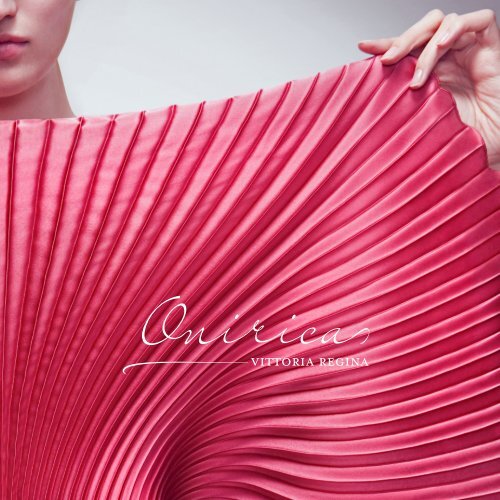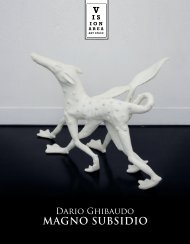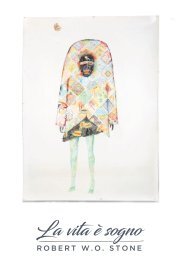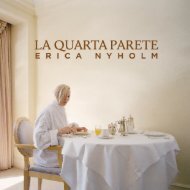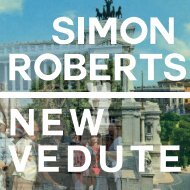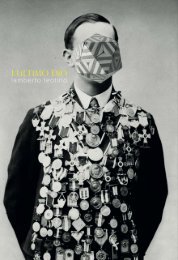WEB_catalogo very regina
Create successful ePaper yourself
Turn your PDF publications into a flip-book with our unique Google optimized e-Paper software.
vittoria <strong>regina</strong>
A cura di<br />
Curated by<br />
Alessandro Riva<br />
Biografia di<br />
Biography by<br />
Klara Murnau<br />
Direzione artistica<br />
Art director<br />
Matteo Basilé<br />
Progetto grafico<br />
Graphic project<br />
Angelo Marinelli<br />
Comunicazione<br />
Communication<br />
ArtistProof s.r.l. Roma<br />
Ufficio stampa<br />
Press office<br />
FOSFORO, Roma<br />
Con il supporto di<br />
Supported by<br />
In collaborazione con<br />
In collaboration with
vittoria <strong>regina</strong>
Vittoria Regina e le mutevoli forme dell’inconscio<br />
di Alessandro Riva<br />
La pratica del travestimento e dell’assunzione di un’identità – o di molteplici identità – diverse da<br />
quella originaria è stata, nell’arte contemporanea, una disciplina diffusa a partire soprattutto dagli<br />
anni Settanta, con l’emergere delle tecniche performative e dell’uso massiccio di video e fotografie<br />
come linguaggi alternativi, o integrativi, rispetto ai più tradizionali mezzi pittorici e scultorei, e<br />
il conseguente ritorno di attenzione verso il corpo inteso come mezzo non solo di espressione<br />
quotidiana del linguaggio non verbale, ma anche come possibile luogo di sperimentazione, anche<br />
estrema, di modi e identità diverse da quelle abituali, e non di rado, conseguentemente, anche come<br />
esercizio liberatorio e catartico, di affrancamento di energie imprigionate o non sufficientemente<br />
esercitate nel tempo “normale” della vita quotidiana e del lavoro.<br />
4<br />
Potenziale mezzo di espressione dell’inconscio profondo e del rimosso, il corpo è tornato così a<br />
dispiegare tutta la sua forza e la sua energia sulla scena dell’arte come antico, ma al contempo<br />
nuovissimo, mezzo (e luogo) di liberazione e di riscatto dalle convenzioni, dalle costrizioni e<br />
dalle gabbie imposte dai normali ritmi della vita sociale. Basti citare, a mo’ d’esempio, i nomi<br />
di alcuni artisti che hanno saputo, in anticipo e in maniera più penetrante e più intelligente di<br />
altri, utilizzare il corpo (e, conseguentemente, anche la pratica del travestimento) come luogo e<br />
metodo di sperimentazione di possibili altri da sé, oltre che come espressione di identificazione e<br />
ridefinizione delle icone e dei simboli della cultura e dell’immaginario passato o coevo: da Luigi<br />
Ontani, che, in perfetta coerenza con i rivolgimenti, i meticciamenti e le citazioni incrociate del<br />
postmodernismo, incarnò da solo, col, e sul, proprio corpo, l’intero assortimento di personaggi<br />
storici, mitologici e letterari della cultura occidentale ed orientale; a Cindy Sherman, che ha<br />
sempre considerato il proprio volto come la “tela bianca su cui intervenire”, mettendo di volta<br />
in volta in scena, con toni tra il grottesco e il caricaturale, gli stereotipi femminili occidentali; a<br />
Yasumasa Morimura, che ha incarnato le icone pop del ventesimo secolo con un effetto insieme<br />
di desacralizzazione, di riflessione e di scardinamento del loro potere di condizionamento e di<br />
modificazione del gusto nella società di massa.<br />
Oggi, una giovane artista e fotografa romana, Vittoria Regina (che già dal nome, vero e non<br />
fittizio, con quell’apparente e sorprendente rovesciamento d’ordine tra “Regina” e “Vittoria”,<br />
sembra miracolosamente incarnare, per certi scherzi del destino che solo la vita quotidiana riesce<br />
a mettere involontariamente in scena, il senso di un percorso artistico e individuale in grado<br />
di interpretare, trasformare e rovesciare gli stereotipi diffusi, semplicemente cambiandone o<br />
ribaltandone il significato più profondo, manipolandone la sintassi o mescolando inavvertitamente
l’ordine degli addendi di cui è composta), una giovane artista, dunque, romana di nascita ma<br />
con lunghi periodi alle spalle di vita e di lavoro fuori dalla Capitale, ha ripreso la tradizione<br />
del travestimento e del lavoro sul corpo e sull’identità, e sulle identità multiple, con grande<br />
rigore formale, un linguaggio fortemente iconico e una forza e una sensibilità del tutto originali.<br />
Vittoria Regina lavora infatti su di sé e sul proprio corpo come spazio aperto, vergine, sul quale<br />
sperimentare di volta in volta visioni impreviste e inaspettate, estratte a sorpresa dall’alveo del<br />
nostro quotidiano, attraverso la creazione, meticolosa quanto professionalmente ineccepibile,<br />
di strane immagini-puzzle di difficile interpretazione, quasi ci si trovasse di fronte a misteriosi<br />
rompicapi visivi e cerebrali, sottilmente, o a volte apertamente, disturbanti, dove la rigidità<br />
dell’ordine formale nelle quali sono inserite e l’imperturbabilità delle espressioni incarnate dalla<br />
sua protagonista sembrano in realtà nascondere le tracce di sottili e oscure ferite esistenziali, che<br />
sembrano aprire varchi verso una diversa interpretazione delle forme stesse del reale. Il carattere<br />
di tali opere è, come avveniva nei quadri dei grandi maestri surrealisti, quello di certi sogni dei<br />
quali ci capita a volte di ricordare non l’intera sequenza, ma soltanto un’immagine, un’istantanea<br />
o anche solo una sensazione, incongrua e sorprendente come appaiono sempre, al risveglio,<br />
incongrue e sorprendenti le immagini e le sensazioni che ci rimandano i sogni, delle quali non<br />
riusciamo magari a decifrare veramente il significato recondito – se di un significato univoco si<br />
può poi realmente parlare –, rendendoci tuttavia conto che esse possiedono, nella loro cristallina<br />
inafferrabilità, qualcosa che ci riguarda nel profondo, che racconta di qualcosa di noi che abbiamo<br />
rimosso o che non abbiamo mai saputo esprimere o analizzare a livello cosciente, e che tuttavia<br />
sappiamo riconoscere come nostro, come appartenente al nostro nucleo esistenziale più intimo e<br />
profondo più di qualsiasi descrizione, o riflessione, logica e razionale.<br />
Sono immagini (o visioni) che sembrano rimandare all’attività onirica secondo la chiave che<br />
proprio Breton restituì al rapporto veglia/sogno fin dal Primo manifesto del surrealismo, quando<br />
parlò della veglia come mero “fenomeno di interferenza” rispetto al momento onirico, che ad<br />
esso rimanda in continuazione come alla vera chiave dei propri comportamenti inconsci, dei<br />
propri lapsus e delle proprie emozioni durante la fase di veglia. È l’eterna storia dell’incerto e vago<br />
procedere del nostro lato ragionante e raziocinante, e del suo sistematico e periodico perdersi,<br />
smarrirsi, lasciarsi andare, pur nel suo “normale funzionamento” diurno, nel corso dunque del<br />
lungo oblìo d’una qualsiasi e “normale” giornata (nel lavoro, nelle relazioni interpersonali, nella<br />
vita quotidiana, in famiglia o con gli amici), a sensazioni, paure, turbamenti, emozioni ed effetti<br />
psicologici che con la razionalità non hanno tuttavia nulla o pochissimo a che spartire, e che<br />
sembrano volersi sempre riallacciare invece – che ci piaccia o meno riconoscerlo –, a quel luogo<br />
che è il più intimo e il più misterioso del nostro nucleo esistenziale, quello che la psicanalisi ha<br />
voluto ribattezzare col nome di inconscio, e che, per similitudine, sembra a sua volta ricollegarsi<br />
in maniera diretta con l’attività che con la parte più irrazionale di noi sembra avere maggior<br />
dimestichezza – quella onirica, appunto. “Per quanto ben fatto esso sia”, scrive Breton a proposito<br />
dello stato di veglia, “il suo equilibrio è relativo; osa appena esprimersi, e, se lo fa, si limita a<br />
constatare che un’idea o una donna gli fa effetto. Quale effetto, sarebbe incapace di dirlo; per<br />
tal via, dà la misura del proprio soggettivismo, e nient’altro. Disperando d’una causa, egli invoca<br />
allora il caso, divinità più oscura delle altre, a cui attribuisce i propri smarrimenti”. Ma, continua
6<br />
l’inventore del surrealismo, “chi mi dice che l’angolo sotto cui si presenta l’idea che lo commuove,<br />
che quello che ama nell’occhio della donna non sia precisamente quanto lo riallaccia al sogno e lo<br />
incatena ai dati che per sua colpa ha perduto?”.<br />
Dati vaganti, perduti per sempre nel vasto e incerto labirinto della nostra memoria profonda,<br />
percorsi onirici che si dipanano lungo fili di cui non ricordiamo, e non riconosciamo, se non pochi<br />
e vaghi scampoli sfuggiti misteriosamente all’oblio, e poi immagini strane, bizzarre, incongruenti,<br />
assurde, impossibili da accettare e da catalogare dal punto di vista fisico, inverosimili anche per gli<br />
inventori degli effetti speciali di Hollywood, disturbanti, fastidiosi, con un piede vuoi nell’osceno,<br />
vuoi nell’eccessivo, vuoi nell’assurdo, vuoi nell’imbarazzante, se non fossero così inaspettatamente<br />
lontane dal concetto stesso di osceno, di eccessivo o di imbarazzante: ecco ad esempio una donna<br />
che reca in testa un alveare, un’altra (la stessa?, ma dove mi è già capitato di vederla?), che si alza<br />
la gonna, con espressione impeccabile, fredda, anodina, senza imbarazzo o ammiccamento di<br />
sorta, e ci mostra quello che non tiene là, tra le gambe: una nicchia vuota, che – guarda un po’ –<br />
contiene una rosa. Una rosa? Se avessimo voluto descriverlo a bella posta, se avessimo voluto farne<br />
una metafora di qualcosa – di un sentimento, di un desiderio, di una mancanza – non avremmo<br />
saputo essere così precisi, così chirurgicamente esatti nel descrivere la somiglianza tra la vellutata<br />
poesia e l’accogliente desiderio delle pieghe di quella gonna, e la perfezione del fiore, al centro di<br />
quell’impossibile, incongruo spazio vuoto, che è già di per sé un simbolo di qualcosa (ma di cosa,<br />
dopotutto? – lo sappiamo, forse, e insieme non vogliamo andare fino in fondo all’analisi razionale, o<br />
psicologica, di quel che voglia, o possa, realmente significare quel vuoto, poiché l’analisi razionale,<br />
in fondo, non ci riguarda così tanto come ci riguarda invece l’immagine stessa che ci viene gettata<br />
addosso, che ci colpisce con maggior forza e con maggior potere di seduzione e di riscatto di una<br />
qualche memoria profonda, ancestrale, che sembra appartenerci dalla notte dei tempi).<br />
Di immagini eminentemente oniriche, dunque, si tratta, e non d’altro, nel caso delle opere di<br />
Vittoria Regina: e non è un caso, allora, che proprio ai sogni, e alle immagini che la stessa artista<br />
ritrova nei sogni, dei quali annota meticolosamente il ricordo appena sveglia su suoi piccoli<br />
quadernetti che tiene sempre accanto al letto (l’unico modo, da che mondo e mondo, per provare<br />
almeno a fissare qualche vaga e abborracciata annotazione dallo sfuggente ricordo di quel che<br />
avviene in quel territorio misterioso che è il processo onirico), non è un caso, dicevamo, che<br />
proprio ai sogni si rifacciano gran parte delle immagini partorite dalla mente di questa singolare<br />
artista bifronte, insieme ideatrice, autrice, regista e attrice unica delle proprie pièce teatrali, delle<br />
proprie pantomime, potremmo dire, o meglio ancora dei propri solitari psicodrammi – giacché<br />
alla visione plastica e perfettamente chiara e intellegibile di psicodrammi, e non ad altro, in fondo,<br />
ci rimandano le immagini di Vittoria Regina: psicodrammi recitati dall’artista rigorosamente en<br />
solitaire, dopo attenta e meticolosa preparazione rituale (come avviene in tutte le cerimonie che<br />
abbiano la pretesa di conquistare nuove frontiere, nuove strade e nuovi scenari all’interno di quel<br />
misterioso labirinto che è il nostro inconscio), giocati su poche e rigide regole e griglie di base, dalle<br />
quali si diparte poi, senza paracadute, potremmo dire, cioè senza un vero ordine precostituito,<br />
senza sapere, in qualche modo, a che cosa quella pur meticolosa e millimetricamente esatta<br />
preparazione potrà alla fin fine portare, l’artista stessa nel mettere in moto la gran macchina della<br />
costruzione, e conseguentemente della scelta, dell’immagine finale.
Vittoria Regina prepara infatti, prima di tutto, il campo, il luogo, le regole, per così dire, e il<br />
metodo di lavoro del proprio solitario spettacolo: dall’ideazione iniziale dell’immagine (prelevata,<br />
come dicevamo, quasi sempre, pur non in via del tutto esclusiva, da una visione estrapolata da un<br />
sogno), alla costruzione di set realizzati appositamente per l’occasione, alla scelta e ricerca degli<br />
accessori, dei trucchi e dei costumi di volta in volta adatti al singolo scatto, per arrivare infine<br />
al momento clou – quello dello scatto, appunto –, realizzato sempre in solitaria, senza l’aiuto di<br />
assistenti, come in una misteriosa e prolungata seduta di auto-analisi (o addirittura di auto-ipnosi);<br />
finendo poi, successivamente, e solo successivamente, con una complessa e articolata opera di<br />
post-produzione dell’immagine, attraverso dettagliate e sofisticate operazioni di giustapposizione<br />
di immagini diverse e di intervento pittorico-digitale sull’opera definitiva.<br />
Quanto c’è, dunque, di Vittoria Regina, la persona, del suo nucleo identitario profondo, dei fantasmi<br />
del suo inconscio, nelle impeccabili, rigorose visioni che Vittoria Regina, l’artista e performer,<br />
estrae dai suoi sogni, per consegnarle prima alla carta, in forma di appunti, poi alla macchina,<br />
in forma di immagini da ricostruire meticolosamente, con i dati, gli elementi, gli accessori (abiti,<br />
acconciature, gioielli) di cui la realtà la fornisce? E quanto c’è della persona Vittoria Regina e<br />
del suo inconscio negli sguardi, nelle espressioni, nell’imperturbabile geometria fisiognomica<br />
che Vittoria Regina la performer, soggetto unico e univoco delle sue foto, riesce a trasmettere<br />
in chi guarda l’immagine finale? Potremmo, com’è spesso compito di quei curiosi compilatori di<br />
similitudini e di rimandi culturali e iconografici che sono i critici d’arte, affaccendarci a trovare<br />
qua un riferimento alle immagini simboliste, là a un’Ofelia riportata in un’atmosfera fashion,<br />
più in là ancora a una sensibilità preraffaellita o, naturalmente, ai bizzarri giochi di scatole cinesi<br />
linguistici o visuali di cui era inesausto campione Salvador Dalí. Il tentativo, pur dialetticamente<br />
e filologicamente corretto, non ci direbbe niente di più delle sorprendenti immagini di questa<br />
artista fattasi, per sua stessa ammissione precocemente, caparbiamente, quasi destinalmente<br />
attrice privilegiata e soggetto unico, obbligato, della sua complessa ricerca artistica, psicologica,<br />
identitaria e formale. Il segreto delle foto di Vittoria Regina, come quello dei sogni, risiede nel<br />
non essere spiegate fino in fondo. È Ofelia o la stessa Vittoria quella che si specchia in sé stessa,<br />
al di là di un immaginario specchio d’acqua, forse in una lunga e strana giornata in un cui era la<br />
sua mente inconscia, e non quella conscia, a guidare l’obiettivo fotografico di Vittoria, l’artista?<br />
E da che lontananza proviene quel volto che sbuca inaspettatamente dietro la cornice barocca di<br />
una vecchia specchiera? Che pensieri oscuri e indicibili reca dentro di sé quel groviglio infausto e<br />
inquietante di stoffe che ricoprono, fornendole quasi la forma di uno strano animale preistorico,<br />
la performer in un momento di oscuramento, di oblio, forse, chissà, di vergogna, del sé razionale?<br />
Che lontani ricordi si affacciano nella mente dell’attrice immortalata, diremmo quasi congelata<br />
nell’atto di eseguire con le mani, senza emozioni né gioia, uno di quei passatempi infantili che<br />
si eseguono tirando in varie maniere un elastico tra le dita? E perché quell’aragosta incastrata<br />
proprio al centro della sua spina dorsale? Perché il melograno, così simbolicamente legato al<br />
culto della nascita e della morte, e il suo aver perso dei chicchi nel corpo della modella? Le<br />
risposte, come l’origine da cui sono nate le immagini, sono riposte nel cuore più fondo dell’animo<br />
dell’artista. E forse un poco anche dentro ognuno di noi.
Vittoria Regina and the changing forms of the unconscious<br />
by Alessandro Riva<br />
8<br />
In contemporary art, the practice of disguise, and the assumption of an identity - or multiple<br />
identities - different from the original one has become a widespread discipline, especially since<br />
the nineteen seventies, with the emergence of performance techniques and the massive use of<br />
video and photographs as alternative or supplementary languages, compared with the more<br />
traditional media of painting and sculpture, and the consequent return of the attention to the<br />
body as a means not only of daily expression of non-verbal language, but also as a possible place<br />
for experimentation, even extreme experimentation, about ways and identities that are different<br />
from the usual ones, and often, consequently, also as a liberating and cathartic exercise, with the<br />
liberation of energies that are imprisoned or not sufficiently exercised in the “normal” rhythms of<br />
daily life and work. As a potential means of expression of the deep unconscious and repression,<br />
the body is thus brought to deploy all its strength and energy on the art scene as an ancient, but<br />
at the same time new, means (and place) of liberation and redemption from conventions, from<br />
the constraints and cages imposed by the normal rhythms of social life. It suffices to mention,<br />
by way of example, the names of some artists who have been able, in advance and in a more<br />
penetrating and more intelligent way than others, to use their body (and, consequently, also<br />
the practice of disguise) as a place and method for experimentation with other possible self,<br />
as well as an expression of identification and redefinition of icons and symbols of culture and<br />
imaginary past or contemporary: from Luigi Ontani, who, in perfect keeping with the upheavals,<br />
the hybridisation and the cross-references of postmodernism, alone embodying by, with, and on<br />
his body the entire assortment of historical, mythological and literary figures of western and<br />
eastern culture; to Cindy Sherman, who has always considered her own face as a “blank canvas on<br />
which to intervene,” presenting Western female stereotypes one after another, with tones between<br />
the grotesque and caricature; to Yasumasa Morimura, who has embodied the pop icons of the<br />
twentieth century with a set of effects of desecration, of reflection and disruption of their power<br />
to influence and change taste in mass society.<br />
Today, a young Roman artist and photographer, Vittoria Regina (who already from the name,<br />
which is real and not fictitious, with that apparent and surprising reversal of order between<br />
“Regina” and “Vittoria”, miraculously seems to embody, in some twist of fate that only daily life<br />
can unwittingly present, the sense of an artistic and personal journey that can interpret, transform<br />
and reverse widespread stereotypes, simply by changing or overturning the deeper meaning, by<br />
manipulating the syntax or inadvertently mixing the order of its component parts): a young artist,<br />
then, Roman by birth but with the experience of long periods living and working outside the
capital, has resumed the tradition of dressing up and working on the body and on identity, and<br />
on multiple identities, with great precision, a highly iconic language and a completely original<br />
strength and sensitivity.<br />
Vittoria Regina is in fact working on herself and her own body as an open, virgin space, on which<br />
to experiment from time to time with unforeseen and unexpected visions, extracted by surprise<br />
from the contraints of e<strong>very</strong>day life, through the creation, as meticulous as it is professionally<br />
impeccable, of strange puzzle-images that are difficult to interpret, as if you are sitting in front<br />
of mysterious visual and brain teasers, subtly, or sometimes openly, disturbing, where the formal<br />
rigidity in which they are placed and the imperturbability of the expressions embodied in her<br />
protagonist seem actually to hide the traces of subtle and obscure existential wounds that seem to<br />
open breaches towards a different interpretation of the same forms of reality. The character of<br />
these works is, as in the paintings of the great surrealist masters, that of certain dreams of which<br />
we happen sometimes to remember not the entire sequence, but only an image, a snapshot or just<br />
a feeling, incongruous and surprising as they always appear and, on waking, the incongruous and<br />
surprising images and feelings that remind us of the dreams, of which we can maybe not really<br />
decipher the hidden meaning - if we can really talk a single meaning - while realising that they<br />
possess, in their crystalline ineffability, something that concerns us deeply, that tells something<br />
about us that we have repressed or that we have never been able to express or analyse at a<br />
conscious level, and yet that we recognise as our own, as belonging to our most intimate existential<br />
and deepest core, more logical and rational than any description or reflection. They are images<br />
(or visions) that seem to refer to the dreamlike activity according to the key that Breton himself<br />
ascribed to the waking/dream relationship since his First Manifesto of Surrealism when he spoke<br />
of waking as a mere “phenomenon of interference” compared with the time of the dream, which<br />
refers to it constantly as the real key of their unconscious behavior, and their lapses and emotions<br />
during waking. It is the eternal story of the uncertain and vague performance of our reasoning<br />
and rational side, and its systematic and periodic loss, destruction and disappearance, even in its<br />
“normal operation” day to day, therefore during the long oblivion of any “normal” day (at work,<br />
in relationships, in e<strong>very</strong>day life, with family or friends), with feelings, fears, anxieties, emotions<br />
and psychological effects which have little or nothing to do with rationality, and which on the<br />
other hand seem to run away - whether we like or not to recognise it - to that place that is the most<br />
intimate and the most mysterious aspect of our existential core, what psychoanalysis has wanted<br />
to rebaptise with the name of the unconscious, and that, by similarity, seems in turn to reconnect<br />
us directly with the most irrational part of us, that also seems to be the most familiar - dreaming,<br />
that is. “As well as it is done,” wrote Breton about the state of wakefulness, “its balance is relative;<br />
it hardly dares express itself, and, if it does, it limits itself to stating that an idea or a woman has<br />
an effect on it. What effect, it would be unable to say; in this way, it gives the measure of its own<br />
subjectivity, and nothing else. Despairing of a cause, it then invokes the case of the darker god of<br />
the other, to which it attributes its own bewilderment.” But, continues the inventor of surrealism,<br />
“Who will tell me that the angle under which the idea that moves him appears, that what he likes<br />
in the eye of the woman is not precisely what links him to dreaming and chains him to the data<br />
that through his own fault he has lost? “
10<br />
Stray data, lost forever in the vast and uncertain maze of our deep memory, dream paths that wind<br />
along threads which we do not remember and do not recognise, apart from a few vague remnants<br />
that have mysteriously escaped from oblivion, and then strange images: bizarre, inconsistent,<br />
absurd, impossible to accept and to catalogue from the physical point of view, too far-fetched for<br />
inventors of Hollywood special effects, disruptive, annoying, with one foot you want the obscene<br />
and the excessive, you want the absurd, the embarrassing - if it was not so unexpectedly far<br />
from the concept of the obscene, excessive or embarrassing: here for example is a woman with<br />
a beehive on her head, another (the same? - but where have I seen her before?) who raises her<br />
skirt, with impeccable expression, cold, anodyne, without embarrassment or any kind of wink,<br />
and shows us what she does not have there, between her legs: an empty niche, that - take a look<br />
- contains a rose. A rose? If we wanted to describe it fully, if we wanted to make a metaphor of<br />
something - a feeling, a desire, a lack - we would not have been able to be so precise, so surgically<br />
precise in describing the similarity between the velvety poetry and the welcoming desire of the<br />
folds of the skirt, and the perfection of the flower, in the middle of that impossible, incongruous<br />
empty space, which is in itself a symbol of something (but what, after all? - we know, perhaps, and<br />
together we do not want to go through with rational or psychological analysis of what that void<br />
will, or can, actually mean, since rational analysis, basically, does not concern us as much as we<br />
are concerned by the image itself that is thrown on us, that strikes us more powerfully and with<br />
greater power of seduction and redemption of some deep, ancestral memory, that seems to belong<br />
to the dawn of time).<br />
It is therefore eminently of dreamlike images, and nothing else, that we are dealing with in the<br />
case of the works of Vittoria Regina: and it is no coincidence, then, that the dreams, and images<br />
that the artist herself finds in dreams, of which she meticulously notes memories as soon as she<br />
wakes up on the little notebooks she keeps beside the bed (the only way, since the world began,<br />
to at least try to fix some vague and muddled annotations from the receding memory of what<br />
happens in that mysterious territory that is the dream process), it is no coincidence, as we were<br />
saying, that it is exactly in dreams that we re-make many of the images arising in the mind of<br />
this singular artist, inventor, writer, director and single actress in her plays and pantomimes, as we<br />
could say, or better yet in her own solitary psychodramas - thus of the plastic and perfectly clear<br />
vision of psychodramas – and it is here and nowhere else, after all, that the images of Vittoria<br />
Regina sends us: psychodrama recited by the artist strictly alone, after careful and meticulous<br />
ritual preparation (as happens in all the ceremonies that claim to conquer new frontiers, new roads<br />
and new scenarios within the mysterious maze that is our unconscious) , played on a few strict rules<br />
and basic grids, from which there then branches off, without a parachute, you might say, what is<br />
without a true pre-established order, without knowing in any way, what this more meticulous and<br />
millimetrically precise preparation could finally provide, the artist herself, when setting off the<br />
whole great machinery of construction, and consequently of choice, of the final image.<br />
In fact, Vittoria Regina first of all prepares the field, the place, the rules, so to speak, and the<br />
method of work of her one-person show: from the initial idea of the image (taken, as we said,<br />
almost always, while not in a totally exclusive manner, from a vision extrapolated from a dream),
the construction of specially made sets for the occasion, the selection and research of accessories,<br />
props and costumes from time to time appropriate to the individual shot, to finally arrive at the key<br />
moment - the shooting moment, in fact - always realised alone, without the help of assistants, as in<br />
a mysterious and prolonged sitting of self-analysis (or even self-hypnosis); then ending, afterwards,<br />
and only afterwards, through complex and intricate post-production work on the image, through<br />
detailed and sophisticated operations of juxtaposition of different images and pictorial-digital<br />
work on the definitive work.<br />
How much is there, then, of Vittoria Regina, the person, the deepest core of her identity, the<br />
ghosts of her unconscious, in the impeccable, rigorous visions that Vittoria Regina, the artist and<br />
performer, extracts from her dreams, to deliver them first on paper, in the form of notes, and then<br />
to the camera in the form of images to be reconstructed meticulously, with the data, elements,<br />
accessories (clothing, hairstyles, jewellery) of which reality provides? And what is there in the<br />
person of Vittoria Regina and her unconscious in the looks, the expressions, the imperturbable<br />
physiognomic geometry that Vittoria Regina the performer, the unique and unequivocal subject<br />
of her pictures, is able to convey to the viewers of her final images? We could, as is often the task<br />
of those curious compilers of similarities and cultural and iconographic references that are art<br />
critics, weary ourselves with finding here a reference to Symbolist images, and thence to Ophelia<br />
transported into an atmosphere of fashion, or further still into a pre-Raphaelite sensibility or, of<br />
course, to the bizarre games of linguistic or visual Chinese boxes of which Salvador Dalí was<br />
a tireless champion. The attempt, though dialectically and philologically correct, would tell us<br />
nothing more of the stunning images of this artist who has, prematurely by her own admission,<br />
stubbornly, almost by destiny, made herself into the privileged actress and single subject, obliged,<br />
by her complex research, at once artistic and psychological, identity-based and formal. The secret<br />
of the photographs of Vittoria Regina, like that of dreams, lies in their not being explained to<br />
the end. Is it Ophelia or Vittoria who is being reflected to herself, beyond a stretch of imaginary<br />
water, perhaps in a long, strange day in which it was her unconscious mind, and not her conscious<br />
self, guiding the photographic lens of Vittoria, the artist? And from what distance comes the<br />
face that emerges unexpectedly behind the baroque setting of an old mirror? What obscure and<br />
unspeakable thoughts does the ominous and disturbing tangle of fabric covering bear within itself,<br />
giving it almost the shape of a strange prehistoric animal, the performer at a time of dimming,<br />
of oblivion: perhaps, who knows, of shame, of the rational self ? That distant memories confront<br />
each other in the mind of the immortalised actress, we would almost say frozen in the act of<br />
performing with her hands, without emotion or joy, one of those childhood pastimes that are<br />
performed by pulling an elastic band in various ways between the fingers? And why is that lobster<br />
stuck right in the middle of her spine? Why the pomegranate, so symbolically linked to the cult<br />
of birth and death, and why has it lost its seeds on the model’s body? The answers, like the source<br />
from which the images came, are placed in the deepest heart of the artist’s soul. And maybe also<br />
a little in all of us.
4 4 /
14
Birth<br />
2009<br />
ultra giclee print<br />
50 x 35 cm
16<br />
Consciousness<br />
2009<br />
ultra giclee print<br />
50 x 35 cm
Passion<br />
2009<br />
ultra giclee print<br />
50 x 35 cm
18
Death<br />
2009<br />
ultra giclee print<br />
50 x 35 cm
20
Memento<br />
2009<br />
ultra giclee print<br />
50 x 35 cm
22<br />
AH #1<br />
2013<br />
C-print<br />
50 x 50 cm
24
AH #2<br />
2013<br />
C-print<br />
50 x 37 cm
26<br />
AH #3<br />
2013<br />
ink jet on Baryta<br />
30 x 20 cm each
AH #4<br />
2013<br />
ink jet on Baryta<br />
30 x 20 cm each
28
FASCINATING
30<br />
FASCINATING #1<br />
2009<br />
digital print on plexiglass<br />
120 x 120 cm
32<br />
FASCINATING #2<br />
2009<br />
digital print on plexiglass<br />
120 x 120 cm
34
36<br />
FASCINATING #3<br />
2009<br />
digital print on plexiglass<br />
120 x 120 cm
38<br />
FASCINATING #4<br />
2009<br />
digital print on plexiglass<br />
120 x 120 cm
40
MEMORIES
42<br />
MEMORIES #1<br />
2016<br />
inkjet on paper<br />
100 x 73 cm
44<br />
MEMORIES #2<br />
2016<br />
inkjet on paper<br />
100 x 73 cm
46
48<br />
Rosening<br />
2013<br />
digital print on plexiglass<br />
114 x 70 cm
50<br />
Temporary portrait<br />
2013<br />
digital print on plexiglass<br />
180 x 120 cm
Unveiled<br />
2013<br />
digital print on plexiglass<br />
180 x 120 cm
52<br />
Le fleur blue<br />
2013<br />
digital print on plexiglass<br />
114 x 70 cm
54<br />
Odissey A<br />
2013<br />
digital print on plexiglass<br />
120 x 120 cm
56<br />
Odissey B<br />
2013<br />
digital print on plexiglass<br />
120 x 120 cm
58
“La bellezza è verità, la verità è bellezza: questo è tutto ciò che voi<br />
sapete in terra e tutto ciò che vi occorre sapere.”<br />
John Keats<br />
60<br />
Vittoria Regina, Romana, è nata per creare icone.<br />
Segue studi artistici che la conducono in una ricerca di visioni sulla bellezza, attraverso la fotografia<br />
si spinge nell’analisi dell’autoritratto di cui è meticolosa sperimentatrice.<br />
Vive tra Roma, Milano e Bruxelles dove dopo aver perfezionato la sua tecnica, dedicandosi in<br />
particolare allo studio della luce ispirata anche al suo utilizzo nell’arte fiamminga, espone<br />
in varie gallerie e fiere in Belgio portando avanti un personale concetto di fotografia dallo stile<br />
unico che sfiora il confine con la pittura.<br />
L’innata attitudine per il fashion, altro tratto caratteristico di ogni sua immagine, arricchisce le sue<br />
opere di una freschezza e modernità che destabilizza chi guarda.<br />
Un viaggio visivo a più livelli quello che nasce dai suoi scatti.<br />
Vittoria Regina fonde il suo lavoro di visual artist con quello di performer e musa per diversi<br />
artisti.<br />
“Non ho mai resistito alla tentazione di intrappolare la bellezza in uno scatto d’eterno. Nelle mie<br />
visioni, vi sono percezioni di attimi e cristallizzazioni della perfezione.<br />
Creo icone e nelle mie opere impongono quelle parole che si traducono in immagini e che nascono<br />
dall’ universo onirico a cui attingo per ogni mia ispirazione”.
“Beauty is truth, truth beauty, that is all.<br />
Ye know on earth, and all ye need to know.”<br />
John Keats<br />
Vittoria Regina, from Rome, was born to create icons.<br />
After her artistic studies oriented towards portrait drawing, she continued her path searching for<br />
her visions of beauty, through photography, and finally to the analysis of her self-portrait of<br />
which she is a meticulous experimenter.<br />
Living between Rome, Milan and Brussels she was able to perfect her techniques, focusing<br />
particularly on the study of light inspired by it’s use in Flemish art, she’s been featured in<br />
several galleries and show reinventing a personal concept of photography which gave light to her<br />
unique style, which gazes the borders of painted art.<br />
Her innate attitude for fashion, another characteristic feature of her images, enriches her works<br />
with freshness and modernity that bewilders who is looking at it.<br />
Vittoria Regina is able to create a visual journey on many levels in her photographs.<br />
She fuse her work as visual artist with performance and as muse for several artists.<br />
“I was never able to resist the temptation of trapping beauty in a snapshot of eternity. In my<br />
visions there are perceptions of instants and crystallisation of perfection.<br />
I create icons, my work imposes those words that translate into images which arise from a dreamlike<br />
universe where I get my inspiration from”.
VISIONAREA Art Space<br />
Auditorium della Conciliazione<br />
Via della Conciliazione, 4 - 00193 - Roma<br />
www.visionarea.org


